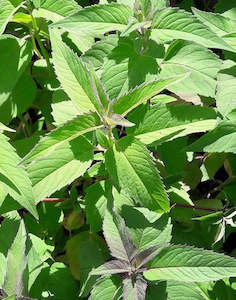Bergamot

Botanical name: Monarda didyma
Life cycle: Perennial
Height: 70-90 cm
Position: Sun or part shade
Soil preference: Moist / well drained
Description
named because of its fragrance, which resembles the aroma of the bergamot orange. It is an aromatic perennial growing to 70-90 cm from a creeping rootstock. The oval shaped, dark green leaves have coarsely toothed margins and reddish veins. The leaves are arranged opposite one another on a hairy, hard, ridged square stem. By mid-summer, the stems are topped by large striking whorled heads that are made up of many tubular reddish to mauve flowers.
A member of the mint family, bergamot is native to North America. Its botanical name, Monarda derives from the Spanish physician, Nicolas Monardes, who first discovered and described it. grew in abundance in the Oswega River district near Lake Ontario and was used by the Oswega Indians. Its popular name, Oswega Tea, reflects this locale. became a popular tea substitute in New England after the Boston Tea Party in 1773.
also known as Oswego Tea, Bee Balm, or Scarlet Monarda.
Uses
Culinary - flowers make an attractive edible garnish in salads. Fresh young leaves may also be used sparingly in salads and as a flavouring in cooked foods such as stuffings and pork dishes. Fresh leaves are also excellent for adding to fresh summer fruits drinks and can be used as flavouring in wines, jellies, and fruit dishes.
Fresh or dried leaves can be brewed into a refreshing aromatic tea. Using the leaves and blossoms creates a tea similar in taste to Earl Grey tea.
Medicinal - Both flowers and leaves are used medicinally, as they contain antibiotic and antiseptic compounds.
The leaves can be infused to make a delicious tea to soothe sore throats, ease symptoms of a cold or flu, or to treat mouth and throat infections. An infusion of the leaves has a soothing effect on the digestive tract and can help to treat indigestion, bloating and nausea. A steam inhalation can be used as a decongestant and to clear the sinuses.
also a nervine, having a gentle calming effect on the nervous system. It is used to treat anxiety and stress and helps with relaxation and to ease tension.
Externally, bergamot leaves can be made into a poultice and used to treat skin infections, ulcers, acne and minor wounds.
The antispasmodic properties in bergamot help it treat menstrual cramps and regulate menstrual flow.
Caution – Avoid in pregnancy.
Household - can also be used for dried floral arrangements and potpourri where they offer long lasting colour.
Companion planting - a good all round companion for plants that need any form of insect pollination, as the flowers are very attractive to bees and other insects. It is also thought to be a good companion to tomato plants.
Growing conditions
likes a hummus rich soil and plenty of water during hot periods as it is shallow rooted. It does best in full sun however can take part shade. Protect from heavy frosts.
The plant can form a mat like growth and will eventually become bare in the centre as the newer outside growth is favoured by the plant. Dividing the plant every 3-4 years keeps it looking attractive and supplies new plants. A good pruning in autumn, close to ground level, will ensure fresh new spring growth.
9cm pot.
Organically grown plant in a biodegradable coir pot.
